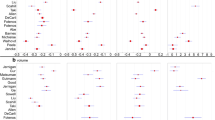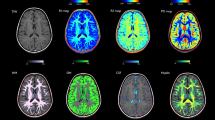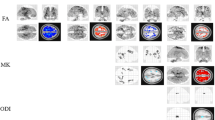Abstract
Purpose
Although the brain has been extensively studied, relationships of gray (GM) to white (WM) matters in individual sections as typically acquired and read radiologically have not yet been examined. A novel GM/WM-based approach with a compact whole brain representation is introduced and applied to study the brain and perform neuroimage processing.
Methods
The gray to white matter ratio GWR defined as GM/(GM+WM) was calculated for 3T T1-weighted axial, coronal, and sagittal sections of 75 normal subjects. The mean (normative) GWR curves were employed to describe the normal brain and quantify aging and to illustrate pathology detection and characterization.
Results
The mean GWR curves characterize the normal brain by only six, neuroanatomy-related numbers. The regions with a significant GWR decline with age surround the ventricular system. The GWR decline rate in males is higher (−0.17%/year) than females (−0.14%/year); moreover, males show a significantly higher decline in middle to elder group. The GWR decline from young (≤25 years) to middle (26–40 years) age group (males/females −0.31%/−0.34%/year) is significantly higher than that from middle to elder (>40 years) group (males/females −0.13/−0.07%/year).
Conclusion
The GWR-based analysis is useful to characterize normal brain, determine significant regions of interest, and quantify healthy aging. It has potential applications in brain compression, comparison, morphometry, normalization, and detecting and quantifying pathologies, which open new avenues in computer-assisted neuroradiology from screening to large brain databases searching.
Similar content being viewed by others
References
Huber P (1982) Cerebral angiography, 2nd edn. Georg Thieme Verlag, Stuttgart
Kretschmann HJ, Weinrich W (2004) Cranial neuroimaging and clinical neuroanatomy, 3rd edn. Georg Thieme Verlag, Stuttgart
Harnsberger HR, Osborn AG, Ross J, Macdonald A (2006) Diagnostic and surgical imaging anatomy: brain, head and neck, spine. Amirsys, Salt Lake City
Schuenke M, Schulte E, Schumacher U, Ross L, Lamperti E, Voll MM, Wesker KH (2007) Head and neuroanatomy. Thieme atlas of anatomy series. Thieme, New York
Schaltenbrand G, Wahren W (1977) Atlas for stereotaxy of the human brain. Thieme, Stuttgart
Netter FH (1986) Nervous system, part 1: anatomy and physiology. Ciba collection of medical illustrations, vol 1. CIBA-GEIGY, New Jersey
Talairach J, Tournoux P (1988) Co-planar stereotactic atlas of the human brain. Georg Thieme Verlag/Thieme Medical Publishers, Stuttgart
Duvernoy HM (1999) The human brain: surface, three-dimensional sectional anatomy with MRI, and blood supply, 2nd edn. Springer, Wien
Mori S, Wakana S, van Zijl PCM, Nagae-Poetscher LM (2005) MRI atlas of human white matter. Elsevier Science, Amsterdam
Sundsten JW, Brinkley JF, Eno K, Prothero J (1994) The digital anatomist. Interactive brain atlas. CD ROM for the Macintosh. University of Washington, Seattle
Hoehne KH (2001) Voxel-Man, Brain and skull. Version 2.0. Springer, Heidelberg
Nowinski WL, Thirunavuukarasuu A (2004) The cerefy clinical brain atlas. Thieme, New York
Nowinski WL, Thirunavuukarasuu A, Volkau I, Marchenko Y, Runge VM (2009) The cerefy atlas of cerebral vasculature. Thieme, New York
Allen JS, Damasio H, Grabowski TJ, Bruss J, Zhang W (2003) Sexual dimorphism and asymmetries in the gray-white composition of human cerebrum. Neuroimage 18: 880–894
Kruggel F (2006) RI-based volumetry of head compartments: normative values of healthy adults. NeuroImage 30: 1–11
Harris GJ, Schlaepfer TE, Peng LW, Federman EB, Pearlson GD (1994) Magnetic resonance imaging evaluation of the effects of ageing on grey-white ratio in the human brain. Neuropathol Appl Neurobiol 20(3): 290–293
Luft AR, Skalej M, Schulz JB, Welte D, Kolb R, Burk K, Klockgether T, Voigt K (1999) Patterns of age-related shrinkage in cerebellum and brainstem observed in vivo using three-dimensional MRI volumetry. Cereb Cortex 9(7): 712–721
Courchesne E, Chisum HJ, Townsend J, Cowles A, Covington J, Egass B, Harwood M, Hinds S, Press GA (2000) Normal brain development and aging: quantitative analysis at in vivo MR imaging in healthy volunteers. Radiology 216: 672–682
Ashburner J, Friston KJ (2000) Voxel-based morphometry—the methods. NeuroImage 11(6 Pt 1): 805–821
Ashburner J, Friston KJ (2005) Unified segmentation. Neuroimage 26(3): 839–851
Gur RC, Bruce IT, Matsui M, Yan M, Bilker W, Hughett P, Gur RE (1999) Sex differences in brain gray and white matter in healthy young adults: correlations with cognitive performance. J Neurosci 19(10): 4065–4072
Ge Y, Grossman RI, Babb JS, Rabin ML, Mannon LJ, Kolson DL (2002) Age-related total gray matter and white matter changes in normal adult brain. Part I: Volumetric MR imaging analysis. AJNR Am J Neuroradiol 23: 1327–1333
Greenberg DL, Messer DF, Payne ME, Macfall JR, Provenzale JM, Steffens DC, Krishnan RR (2008) Aging gender, and the elderly adult brain: an examination of analytical strategies. Neurobiol Aging 29: 290–302
Smith CD, Chebrolu H, Wekstein DR, Schmitt FA, Markesbery WR (2007) Age and gender effects on human brain anatomy: a voxel based morphometric study in healthy elderly. Neurobiol Aging 28: 1075–1087
Cuadra MB, Cammoun L, Butz T, Cuisenaire O, Thiran J (2005) Comparison and validation of tissue modelization and statistical classification methods in T1-weighted MR brain images. IEEE Trans Med Imaging 24(12): 1548–1565
Bevington PR (1969) Data reduction and error analysis for the physical sciences. McGraw-Hill, New York
Gehrels N (1986) Confidence limits for small number of events in astrophysical data. Astrophys J 303: 336–346
Armitage P, Berry G, Matthews JNS (2002) Statistical methods in medical research, 4th edn. Blackwell Scientific Publishing, Oxford
Schumaker L (2007) Spline functions: basic theory. Cambridge University Press, New York
Whitwell JL (2009) Voxel-based morphometry: an automated technique for assessing structural changes in the brain. J Neurosci 29(31): 9661–9664
Goldszal AF, Davatzikos C, Pham DL et al (1998) An image-processing system for qualitative and quantitative volumetric analysis of brain images. J Comput Assist Tomogr 22(5): 827–837
Davatzikos C, Genc A, Xu D et al (2001) Voxel-based morphometry using the RAVENS maps: methods and validation using simulated longitudinal atrophy. NeuroImage 14(6): 1361–1369
Klauschen F, Goldman A, Barra V et al (2009) Evaluation of automated brain MR image segmentation and volumetry methods. Hum Brain Mapp 30: 1310–1327
Jack CR Jr, Bernstein MA, Fox NC et al (2008) The Alzheimer’s disease neuroimaging initiative (ADNI): MRI methods. J Magn Reson Imaging 27(4): 685–691
Edelman RR, Dunkle E, Koktzoglou I et al (2009) Rapid whole-brain magnetic resonance imaging with isotropic resolution at 3 Tesla. Invest Radiol 44(1): 54–59
Kakeda S, Korogi Y, Hiai Y et al (2007) Detection of brain metastasis at 3T: comparison among SE, IR-FSE and 3D-GRE sequences. Eur Radiol 17(9): 2345–2351
Deoni SCL, Williams SCR, Jezzard P et al (2008) Standardized structural magnetic resonance imaging in multicentre studies using quantitative T1 and T2 imaging at 1.5 T. Neuroimage 40(2): 662–671
Coffey CE, Lucke JF, Saxton JA et al (1998) Sex differences in brain aging—a quantitative magnetic resonance study. Arch Neurol 55(2): 169–179
Lemaitre H, Crivello F, Grassiot B et al (2005) Age and sex related effects on neuroanatomy of healthy elderly. NeuroImage 23(3): 860–868
Jernigan TL, Gamst AC (2005) Changes in volume with age-consistency and interpretation of observed effects. Neurobiol Aging 26(9): 1271
Fotenos AF, Snyder AZ, Girton LE et al (2005) Normative estimates of cross sectional and longitudinal brain decline in ageing and AD. Neurology 64(6): 1032–1039
Walhovd KB, Fjell AM, Reinvang I et al (2005) Effects of age on volume of cortex, white matter and subcortical structures. Neurobiol Aging 26(9): 1261–1270 (discussion 1275–1278)
Good CD, Johnsrude IS, Ashburner J et al (2001) A voxel based morphometric study of ageing in 465 normal adult human brains. Neuroimage 14(1pt 1): 21–36
Allen JS, Bruss J, Brown CK et al (2005) Normal neuroanatomical variation due to age: the major lobes and a parcellation of the temporal region. Neurobiol Aging 26(9): 1245–1260 (discussion 1279–1282)
Joshi SH, Horn JD, Toga AW (2009) Interactive exploration of neuroanatomical meta-spaces. Front Neuroinformatics 3:Article 38
Herskovits EH, Chen R (2008) Integrating data-mining support into a brain-image database using open-source components. Adv Med Sci 53(2): 172–181
Nowinski WL, Qian G, BhanuPrakash KN et al (2006) Fast Talairach transformation for magnetic resonance neuroimages. J Comput Assist Tomogr 30(4): 629–641
Nowinski WL, Bhanuprakash KN (2005) Dorso-ventral extension of the Talairach transformation and its automatic calculation for MR neuroimages. J Comput Assist Tomogr 29(6): 863–879
Chow SC, Shao J, Wang H (2008) Clinical size calculations in clinical research, 2nd edn. Chapman & Hall/CRC Biostatistic series, Boca Raton
Lerman J (1996) Study design in clinical research: sample size estimation and power analysis. Can J Anaesth 43(2): 184–191
Author information
Authors and Affiliations
Corresponding author
Rights and permissions
About this article
Cite this article
Nowinski, W.L., Gupta, V., Chan, W.Y. et al. Use of normative distribution of gray to white matter ratio in orthogonal planes in human brain studies and computer-assisted neuroradiology. Int J CARS 6, 489–505 (2011). https://doi.org/10.1007/s11548-010-0538-0
Received:
Accepted:
Published:
Issue Date:
DOI: https://doi.org/10.1007/s11548-010-0538-0




